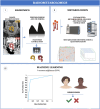Multi-omics staging of locally advanced rectal cancer predicts treatment response: a pilot study
- PMID: 38538828
- PMCID: PMC11088547
- DOI: 10.1007/s11547-024-01811-0
Multi-omics staging of locally advanced rectal cancer predicts treatment response: a pilot study
Abstract
Treatment response assessment of rectal cancer patients is a critical component of personalized cancer care and it allows to identify suitable candidates for organ-preserving strategies. This pilot study employed a novel multi-omics approach combining MRI-based radiomic features and untargeted metabolomics to infer treatment response at staging. The metabolic signature highlighted how tumor cell viability is predictively down-regulated, while the response to oxidative stress was up-regulated in responder patients, showing significantly reduced oxoproline values at baseline compared to non-responder patients (p-value < 10-4). Tumors with a high degree of texture homogeneity, as assessed by radiomics, were more likely to achieve a major pathological response (p-value < 10-3). A machine learning classifier was implemented to summarize the multi-omics information and discriminate responders and non-responders. Combining all available radiomic and metabolomic features, the classifier delivered an AUC of 0.864 (± 0.083, p-value < 10-3) with a best-point sensitivity of 90.9% and a specificity of 81.8%. Our results suggest that a multi-omics approach, integrating radiomics and metabolomic data, can enhance the predictive value of standard MRI and could help to avoid unnecessary surgical treatments and their associated long-term complications.
Keywords: Magnetic resonance imaging; Metabolomics; Multi-omics; Radiomics; Rectal cancer; Treatment response.
© 2024. The Author(s).
Conflict of interest statement
The authors declare they have no competing interests.
Figures





References
-
- Habr-Gama A, Perez RO, Nadalin W, Sabbaga J, Ribeiro U, Jr, Silva e Sousa AH, Jr, Campos FG, Kiss DR, Gama-Rodrigues J. Operative versus nonoperative treatment for stage 0 distal rectal cancer following chemoradiation therapy: long-term results. Ann Surg. 2004;240(4):711–717. doi: 10.1097/01.sla.0000141194.27992.32. - DOI - PMC - PubMed
-
- van der Valk MJM, Hilling DE, Bastiaannet E, Meershoek-Klein Kranenbarg E, Beets GL, Figueiredo NL, Habr-Gama A, Perez RO, Renehan AG, van de Velde CJH, Consortium I. Long-term outcomes of clinical complete responders after neoadjuvant treatment for rectal cancer in the International Watch & Wait Database (IWWD): an international multicentre registry study. Lancet. 2018;391(10139):2537–2545. doi: 10.1016/S0140-6736(18)31078-X. - DOI - PubMed
-
- Beets-Tan RGH, Lambregts DMJ, Maas M, Bipat S, Barbaro B, Curvo-Semedo L, Fenlon HM, Gollub MJ, Gourtsoyianni S, Halligan S, Hoeffel C, Kim SH, Laghi A, Maier A, Rafaelsen SR, Stoker J, Taylor SA, Torkzad MR, Blomqvist L. Magnetic resonance imaging for clinical management of rectal cancer: updated recommendations from the 2016 European Society of Gastrointestinal and Abdominal Radiology (ESGAR) consensus meeting. Eur Radiol. 2018;28(4):1465–1475. doi: 10.1007/s00330-017-5026-2. - DOI - PMC - PubMed
MeSH terms
LinkOut - more resources
Full Text Sources
Medical

